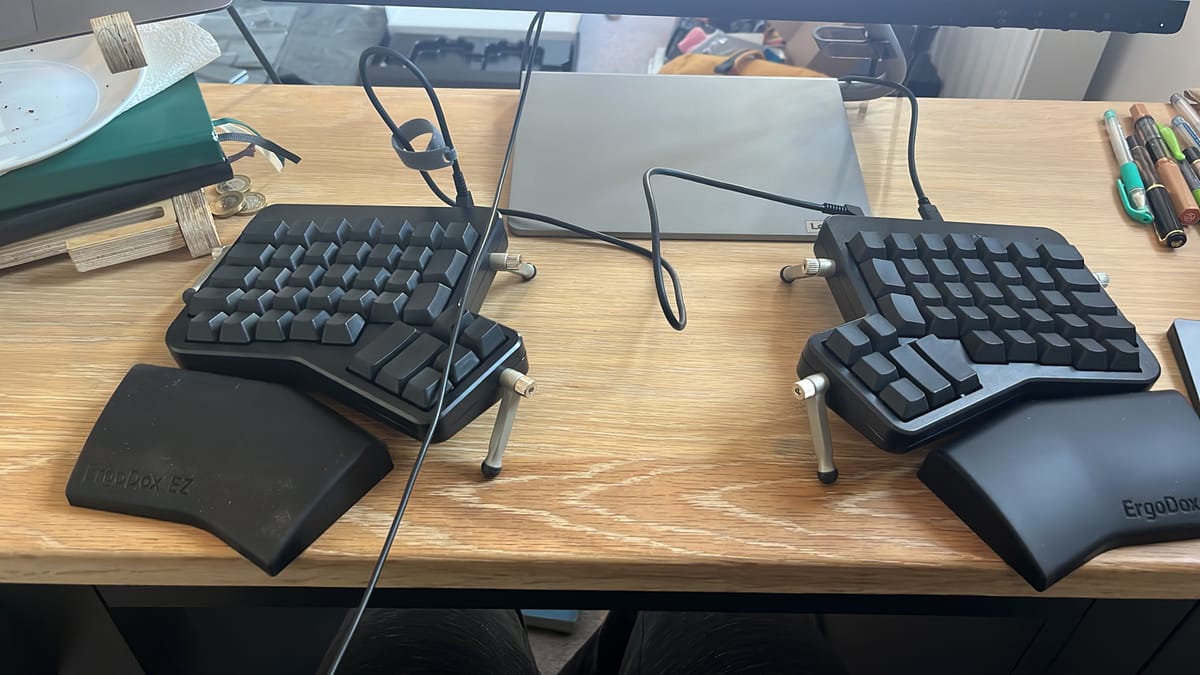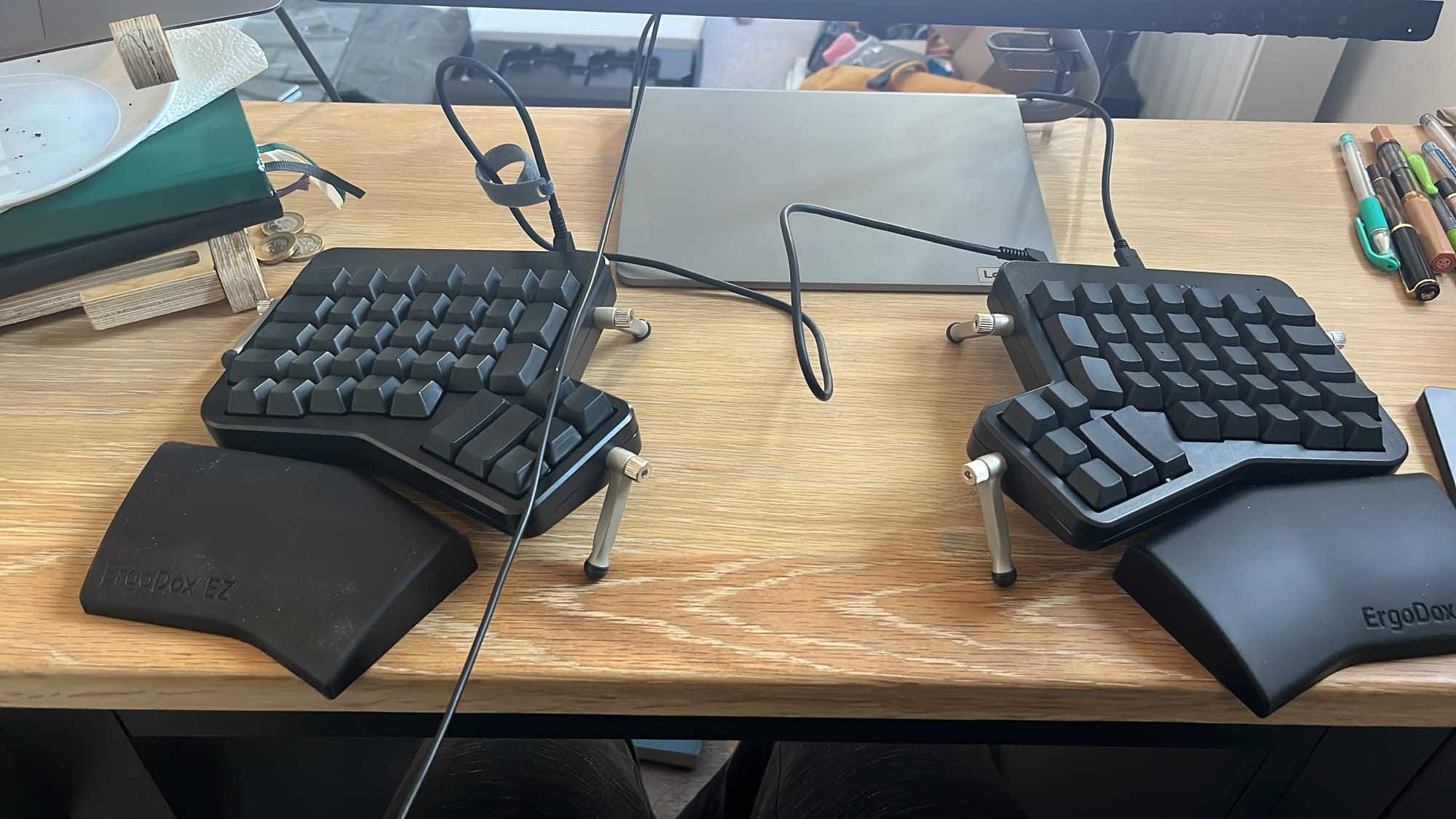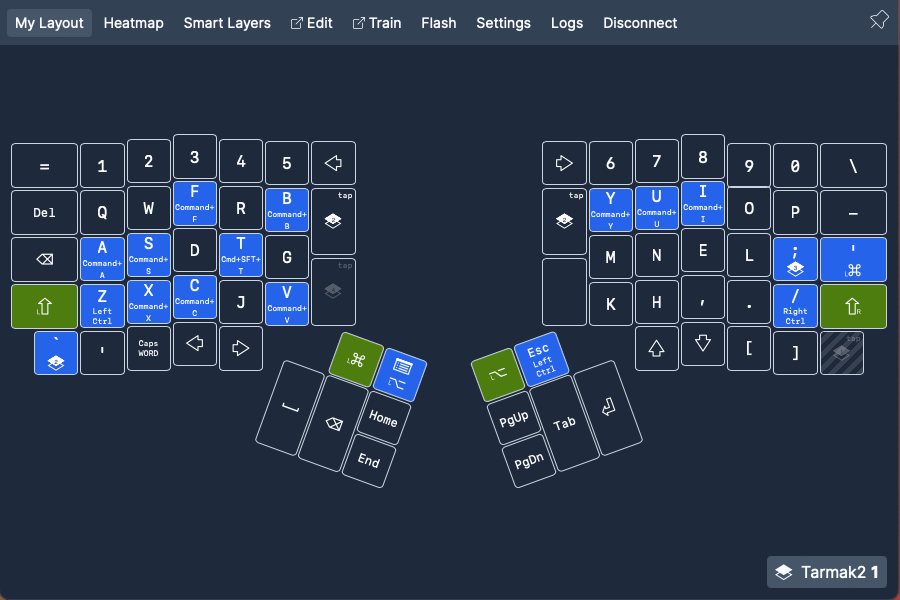new keyb

I got a new keyboard this week. It's an ergonomic split keyboard with an ortholinear (or columnar it you want to get really granular) setup and is tiltable and programmable and who knows what else. Oh, and fun. And currently, because I am also taking the switch up opportunity to learn a new keyboard layout, very very slow.
I'm doing all this because, not for the first time, I found myself racking up high word volume days and walking away with achey wrists. It was especially bad during the couple months I was working on Ambessa's first draft last year. At the time, I thought it was enough to roll up a towel in front of my apple keyboard and keep going. But I don't want to go through that again. A few writer friends of mine showed off their ergo boards and sang the praises of the Dvorak layout (shout out to K. A. Doore and Devin Madson, go read their books), so I started doing my own research. I ended up deciding on an ErgoDox EZ and the Colemak-DH layout.
Some aficionados recommend to learn the split keyboard first; along with the slightly different placement of the letters themselves, many of the modifier keys have...well, shifted. Ortholinear keyboards get rid of the archaic staggering of the traditional board. All the keys go straight up and down. Which means my fingers should also just go straight up and down. (In theory. I'm dealing with decades worth of muscle memory here.) Then we have the little side modules and the thumb panels, meant to use your most robust finger for more than just the space bar. As you can see, there's a lot to get on with already.

But no, that's not enough for some of us. Some of us wanted to be efficient. Some of us wanted to be exceptional.
So I decided to let my learning the board coincide with learning a new layout of letters on the keyboard, again in the name of efficiency and future comfort when I'm halfway through my next novel. I'm learning Colemak-DH through the method called Tarmak, which changes just a few letters at a time (Colemak changes fewer letters than Dvorak, part of my rationale for choosing it). After spending a few days with the first loop, I added in the second loop, which is definitely a challenge, but I start my days doing some drilling on type trainers, like Oryx, which is native to the Ergodox, as well as Colemak Camp and Ngram. Eventually, I will use some of the other programs, but they're not as useful when I'm not at full Colemak yet, and I don't want to train muscle-memory that I'm only going to try to untrain later. Hopefully soon.

A quick test right before my new keyb (as the cool kids say) said my typing speed was 80ish words per minute. Now, I'm lucky it I can hit a 30 wpm and maintain accuracy above 95%. So obviously the goal is to get back there and higher, but slow is smooth, smooth is fast. I would love to be able to type my novel and let that be practice enough, but I'm finding that that requires to much thought and my brain has to slow down too much which bottlenecks the story and just ends up frustrating all around. Instead, my current plan is to write longhand and get my practice in the transcribing. Something like this post, on the other hand, requires a bit less thought (sorry) and is less creative—I'm just talking.
A couple other cool things about this bad boy:
- I can program any of the keys to be anything—so, yeah, I can change alphabet layout, but I can also change single letters, I can put the hyphen key within reach instead of the backslash which I never use, and I can turn keys into full shortcuts. One of my favorites is that I changed all of those usual word document shortcuts like copy, paste, cut (cmd/ctrl+c/p/x/z/etc.) to also live on their respective letters. If I tap and hold the letter, it does the shortcut instead! This is especially useful because I can't remember where cmd is right now...
- Also, layers! Which is hard to explain, but basically it means I can have up to 32 keyboards in one.
- I can tent or tilt it based on my own preferences, spread as far apart as I want
- THERE ARE NO LETTERS. Apparently, you can divide Gen Z and Mills by who touch types and who doesn't. Also, I was traumatised by someone commenting on the state of my laptop keys where so many of the letters have rubbed off. I write a lot of words, okay?! Anyway, no letters, no snarking, problem solved. (Jokes aside, if you want to learn to touch type, regardless of layout, the above training tools will work for you, too. Also try keybr and monkeytype.)
- This a mechanical keyboard, so not only do I have a supremely satisfying tactile feel, I also have that tok-tok sound. Both the keycaps and the keyswitches are changeable, too, so if I want to, I can dive deeper into yet another hobby and spend untold dollars like I do on dice and swords—
Anyway.

I hope you all have enjoyed this different angle of process talk. Thank you for serving as typing practice. Do any of you use alt-layouts or have fun mechanical keyboard setups? Let me know because, if you can't tell, I'm currently obsessed.
Stay sharp, my friends.
C. L.
